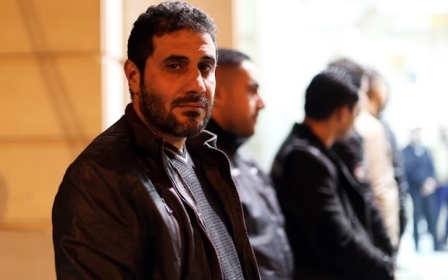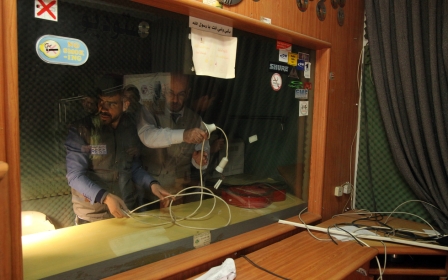Lockdown: Hebron bears brunt of Israeli-Palestinian upheaval

HEBRON, West Bank - The upheaval in the occupied Palestinian territories and Israel that began more than two months ago shows no sign of slowing down as it continues well into December. Clashes are still are a daily occurrence, protesters are shot dead at an all-too-familiar frequency and Palestinian attacks against Israelis are reported multiple times a week.
More than 123 Palestinians have been shot dead by Israeli soldiers and settlers and 19 Israelis have died in individual Palestinian attacks since the start of October.
The region is as tense as ever, but one area in particular seems to be bearing the brunt of the violence.
The southern West Bank district of Hebron is no stranger to conflict. Hebron city is home to the only city-centre in the West Bank in which Israeli settlers and Palestinian residents live side by side, and it has never been a peaceful coexistence.
Thousands of soldiers are deployed in the centre to protect a few hundred settlers, and Palestinian freedom of movement in the city has been severely restricted for years.
Recently, those restrictions on movement have spread throughout the district. With around 30 percent of the Palestinians who have been shot dead during alleged attacks since the start of October having been from Hebron, the district and its residents are on lockdown.
Halhul lockdown
In Halhul, a town that is home to more than 22,000 people, only one road remains open to traffic, but the access is limited.
Residents told Middle East Eye that people who live in Halhul can drive in, but residents are not allowed to drive out. The fine for a resident getting caught leaving the village in a vehicle is reportedly 1,000 shekels ($257), more than many residents’ monthly wages.
Instead, those seeking to leave the town wait outside near an entrance closed off with large concrete blocks for public transport or friends and family to pick them up. Those entering the neighbourhood are dropped off on one side of the blockade, and catch a ride from Halhul vehicles on the other side of the concrete closure.
Mahmoud Tharaja, a resident of Halhul, told MEE that the conditions are making life unbearably complicated.
“Just going to school or work is so hard now,” Tharaja explained, leaning on one of the large slabs of concrete. “All of us need cars, we need to drive. All of us work and study outside of the village, there is no industry inside, just homes.”
Just as Tharaja points out that those with families and the elderly are most affected by the blockade, an elderly woman is dropped off at the entrance and begins climbing up toward the closed off town with large bags of groceries in her hands.
“Look at this lady, try to understand all the aspects of having your home closed off like this,” Tharaja said. “It’s too hard, this is not life.”
'Like a prison'
On 11 December, a Palestinian identified by local media as 55-year-old Omar al-Haroub allegedly attempted to ram his car into a group of Israeli forces in Halhul and was shot dead at the scene. However, residents said the closure happened weeks before the incident.
In Beit Ummar, another large town in Hebron, residential areas have been closed off by checkpoint. However, cars are being allowed in and out after Israeli army inspections.
Ali Alami, a resident of Beit Ummar, said that while his work should be a 10-minute drive from his home, it now takes him close to an hour to get home due to traffic built up at checkpoints. Instead Alami tends to walk to work most days, or catch a ride at one of the shuttered entrances.
Today, Alami is waiting for his wife to get dropped off at one of the blocked off routes. Taxi drivers no longer risk getting stuck in line to enter or exit the residential areas, and will only drive to and from entrances.
“All of Hebron is like this now; it’s all closed off like a prison,” Alami told MEE. “We find ways to live around this humiliation, but it is not easy.”
Residents in Beit Ummar have found ways to get around the Israeli closure, but the risks are high. Alami points at a car carefully making its way through a gap made between two concrete blocks, saying he does not think it’s worth it.
“If they catch him doing that right now [the Israeli forces] will take his car and fine him huge,” Alami said. “It’s happened many times before.”
The Israeli military presence in the Hebron district is highly visible. Nearly every side road off the main route that runs through the district is situated with a checkpoint.
In the village of Saer, where several attackers have reportedly been from, a flying checkpoint on the main road to the village is just a precursor to another more thorough checkpoint closer to the residential boundaries.
Al-Arrub refugee camp, known for being politically charged, has been completely closed off to all cars, with vehicles not allowed in or out.
Thaer Shareef, a young man from the camp, told MEE that because the closure requires a constant Israeli army presence, clashes at the camp sometimes break out multiple times a day.
“They’ve closed off the camp 100 percent,” Shareed said. “And the soldiers are always tense - it’s dangerous that they are tense like this. If anyone even looks at them they raise their guns up to our faces.”
Shareed said he has heard that the blockade of the main road at al-Arrub may be lifted for a few hours a day in the coming few days.
“If they open it just a few hours, it could help. I haven’t seen our roads open here since the second week of October,” he said. ”Look around us, it’s too hard for the people to live like this.”
New MEE newsletter: Jerusalem Dispatch
Sign up to get the latest insights and analysis on Israel-Palestine, alongside Turkey Unpacked and other MEE newsletters
Middle East Eye delivers independent and unrivalled coverage and analysis of the Middle East, North Africa and beyond. To learn more about republishing this content and the associated fees, please fill out this form. More about MEE can be found here.




